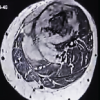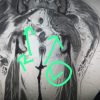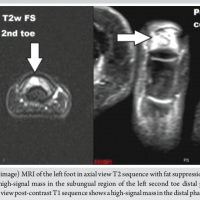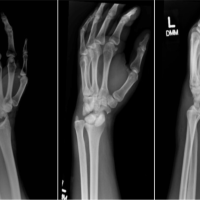[box type=”bio”] What to Learn from this Article?[/box]
Glomus tumors very rarely occur on the thenar eminence of the ha nd, however careful evaluation of such tumors is recommended by the authors to avoid misdiagnosis and ordeal to the patient.
Case Report | Volume 6 | Issue 3 | JOCR July-Aug 2016 | Page 43-45 | Supreeth Nekkanti, Archana Meka, Shashikiran R, Sunila Ravi. DOI: 10.13107/jocr.2250-0685.498
Authors: Supreeth Nekkanti[1], Archana Meka[2], Shashikiran R[1], Sunila Ravi[3]
[1]Department of Orthopaedics, JSS Hospital & University. Mysore. India.
[2]Department of Dermatology, JSS Hopsital & University. Mysore. India.
[3]Department of Pathology, JSS Hospital & University. Mysore. India.
Address of Correspondence
Dr. Supreeth Nekkanti,
No 160, 11th cross, 5th main, 1rst Stage, NGEF Layout, Nrupatunganar, Nagarbhavi, Bangalore -560072. India.
E-mail: drsupreethn@gmail.com
Abstract
Introduction: Glomus body is an apparatus present in the skin at the arterio-venous junction whose main function is to control the body temperature. Hyperplasia of the glomus body results in an entity called glomus tumor. Masson described this entity first in 1924, as a tumor of the neuromyoarterial body. Due to its symptoms, it is often misdiagnosed and wrongly treated which adds burden to the patient.
Case Report: We report a rare case of glomus tumor presenting at an unusal site that is the thenar eminence of the palm. He had been misdiagnosed and wrongly treated for carpal tunnel syndrome. The tumor was surgically excised and diagnosis was confirmed by histopathological studies. We present this case for its rarity, unusual presentation and it being a cause for misdiagnosis.
Conclusion: The common sites of glomus tumors are the finger tips or under the nail. Many such cases have been reported in the literature. We present this case because of its unusual site of presentation and a cause of misdiagnosis. The authors feel that this report could offer a learning experience to orthopaedic surgeons when similar patients present to them to avoid adding burden to the already anxious patient.
Keywords: glomus tumor, thenar eminence, misdiagnosis, carpal tunnel syndrome.
Introduction
Glomus body is an apparatus present in the skin at the arterio-venous junction whose main function is to control the body temperature. Hyperplasia of the glomus body results in glomus tumor. Masson described the entity first in 1924, as a tumor of the neuromyoarterial body [1]. Clinical diagnosis is sufficient to diagnose this tumor if the clinician has a high index of suspicion. Stabbing pain, paroxysmal pain and cold hypersensitivity have been described as the classic triad of glomus tumor by Carroll in 1972 [2, 3, 4]. If this condition is not diagnosed early, it leads to unsuccessful treatment and anxiety to the patient. We report a similar case of glomus tumor of the thenar eminence of the hand which was misdiagnosed as carpal tunnel syndrome and treated for the same.
Case Report
A 55-year-old male presented to us with complaints of a stabbing pain of his right palm. He complained of sharp shooting pain while working or handling objects. He had consulted a neurologist and was diagnosed with carpal tunnel syndrome and started on medication and physiotherapy. Nerve conduction studies done for median nerve were normal. His symptoms failed to subside following which he presented to us. On inspection, the right hand was apparently normal. There was no discoloration or presence of any abnormal swelling. On palpation, there was a focal point of tenderness of his right thenar eminence. A small tender nodule was felt on deep palpation of his right thenar eminence. Carroll’s triad was clinically positive in this patient. There was no distal neurovascular deficit. After palpation of a tender nodule, he was advised an ultasonography scan. The scan revealed a highly vascularized solitary nodule of around 1×1 cm. A provisional diagnosis of hemangioma was offered. The focal area of tenderness was demarcated. A 2 cm incision was made over the demarcated area. Blunt dissection revealed a solitary reddish blue nodule of around 1x1x1 cm in size (Fig.1). The dissection was carried out around the mass and was excised in toto (Fig.2). A thorough wound wash was given and wound was closed in layers. Post operative period was uneventful.Histopathology studies showed multiple blood vessels. The blood vessels were surrounded by tumor cells with dense abundant cytoplasm and multiple nucleoli. Features were suggestive of Glomagioma. (Fig.2).
Discussion
In our literature review, glomustumor (GT) accounts for 2% of all soft tissue tumors [5]. A meager 1-5% of all neoplasms in the hand are reported to be glomustumors [6]. More than 90% of glomus tumors occur in the finger tips. Extra-digital GT have been reported sporadically in sites like elbow, thigh, forearm and even the gastrointestinal tract [7, 8, 9, 10, 11]. We found only two previously reported articles by Gabriele Scaravilli et al who reported a case of glomustumor in the thenar eminence in a patient with neurofibromatosis type 1in 2015 [12]. Brems et al hypothesized that the GT might arise from myofibroblasts derived from the neural crest stem cell in neurofibramotosis due to similar pathogenic mechanisms [13]. However, our patient had no co-morbidities to possibly explain the unusual site which has been described only in one other case which was reported in 1956, by Rieunau G et al. [10]. GT has a predilection for women in the age group of 20-40 years [14]. In our case, the patient was a male aged 55 years which is unusual. Clinical diagnosis of GT is based on Carroll’s triad. It consists of Love’s test, Hildreth’s test and cold hypersensitivity. Love’s test is performed by eliciting excruciating pain on blunt probing of the affected area using a pin head. This test can usually be demonstrated by a focal point of tenderness due to the fact that glomus tumors are usually not more than 15mm x 10mm in size. It has a sensitivity of 78% and specificity of 100% [15]. Hildreth’s test is done by eliciting attenuation in pain after applying a tourniquet and inflating it. Pain returns on deflation. It has been described to have a sensitivity of 71.4% and specificity of 100% [15]. Cold hypersensitivity test reproduces the excruciating pain on dipping the hand in cold water. It has a sensitivity and specificity of 100% [15]. The pain described on performing all these tests is analogous to that of a” hammer blow”. Clinical diagnosis can be done in 90% of the cases if there is a high index of suspicion. There is usually no requirement of further investigations if a thorough clinical evaluation is done. In our patient, all the tests were positive and hence, glomus tumor was considered as the potential diagnosis. We advised the patient an ultrasound scan of the palm to know the extent of the tumor. Ultrasonography revealed a solid, homogenous, hypo echoic, hyper vascular well demarcated nodule of around 1 cm in size. This is consistent with the findings in literature. The only treatment that has been advocated by most surgeons is complete surgical excision. We surgically excised the tumor and sent it for histo-pathological confirmation. Histopathology confirmed our suspicion. The recurrence rate following surgery ranged from 0% to 33.3%. [16]. The patient had complete pain relief with no recurrence reported up to 18 months of follow-up.
Conclusion
Glomus tumors are rare tumors. They predominantly occur in the fingertips of the hand. Extra-digital glomus tumors are uncommon and difficult to diagnose. A high index of suspicion is required to make such rare diagnosis. These are often missed and misdiagnosed as in our case. Clinical evaluation is enough to make a diagnosis in 90% of the cases. If the tumor is not easily palpable as in our patient, then diagnostic tools such as ultrasonography and MRI can be used to confirm the diagnosis.
Clinical Message
Glomus tumors of the hand cause discomfort to the patient and lead to anxiety and depression due to the fact that the patient is often unable to handle objects or perform any fine skilled activity using his hands. After surgical excision, the dramatic relief of symptoms is encouraging to the surgeon and the patient as well. Hence, careful evaluation of such tumors is recommended by the authors to avoid misdiagnosis and ordeal to the patient.
References
1. Gombos Z, Zhang PJ. Glomus tumor. Arch Pathol Lab Med. 2008;132(9):1448-52.
2. Carroll RE, Berman AT. Glomus tumors of the hand: review of the literature and report on twenty-eight cases. J Bone Joint Surg Am. 1972;54(4):691-703
3. Love JG. Glomus tumors: diagnosis and treatment. Proc Staff Meet, Mayo Clin. 1944;19:113–6
4. Giele H. Hildreth’s test is a reliable clinical sign for the diagnosis of glomustumors. J Hand Surg Br. 2002;27(2):157-8.
5. Proietti A, Ali G, Quilici F, Bertoglio P, et al. “Glomus tumor of the shoulder: a case report and review of the literature,” Oncology Letters 2013;6(4):1021–1024.
6 Akgun RC, Guler UO, and Onay U. “A glomustumoranteriortothe patellar tendon: a case report,” Acta Orthopaedica et Traumatologica Turcica 2010;44(3):250-253.
7. Chun JS, Hong R, and Kim JA. “Extradigital glomus tumor: a case report,” Molecular and Clinical Oncology 2013;2:237– 239..
8. Goncalves R, Lopes A, Julio C, Durao C, et al. “Knee glomangioma: a rare location for a glomus tumor,” Rare Tumors vol. 6, no. 4, article 5588, 2014.
9. Balaram AK, Hsu AR, Rapp TB, Mehta V. “Large solitary glomus tumor of the wrist involving the radial artery”. The American Journal of Orthopedics 2014;43(12):567-570.
10. Chen KB and Chen L. “Glomus tumor in the stomach: a case report and review of the literature”. Oncology Letters 2014;7(6):1790-1792.
11. Barua R. “Glomus tumor of the colon. First reported case”. Diseases of the Colon and Rectum 1988;31(2):138-140.
12. Scaravilli G, Rossi R, Artiaco S et al “Glomus tumor of the thenar eminence in neurofibromatosis type 1: case report and literature review”.Translational Medicine UniS. 2015;11(12): 63-68.
13. Brems H, Beert E, de Ravel T, Legius E. Mechanisms in the pathogenesis of malignant tumors in neurofibromatosis type Lancet Oncol. 2009;10(5):508-15.
14. Schiefer TK, Parker WL, Anakwenze OA, Amadio PC, et al. Extradigital glomus tumors: a 20-year experience. Mayo Clinic Proceedings 2006;81(10):1337-44.
15. Bhaskaranand K, Navadgi BC. Glomus tumour of the hand. J Hand Surg [Br]. 2002; 27(3):229–231.
16. De Maerteleire W, Naetens P, De Smet L. Glomus tumors. Acta Orthop Belg. 2000;66(2):169–173.
| How to Cite This Article: Supreeth Nekkanti, Archana Meka, Shashikiran R, Sunila Ravi. A rare case of Glomus Tumor of the Thenar Eminence of the Hand Misdiagnosed as Carpal Tunnel Syndrome. Journal of Orthopaedic Case Reports 2016 July-Aug;6(3):43-45. Available from: https://www.jocr.co.in/wp/2016/07/10/2250-0685-498-fulltext/ |
[Full Text HTML] [Full Text PDF] [XML]
[rate_this_page]
Dear Reader, We are very excited about New Features in JOCR. Please do let us know what you think by Clicking on the Sliding “Feedback Form” button on the <<< left of the page or sending a mail to us at editor.jocr@gmail.com





